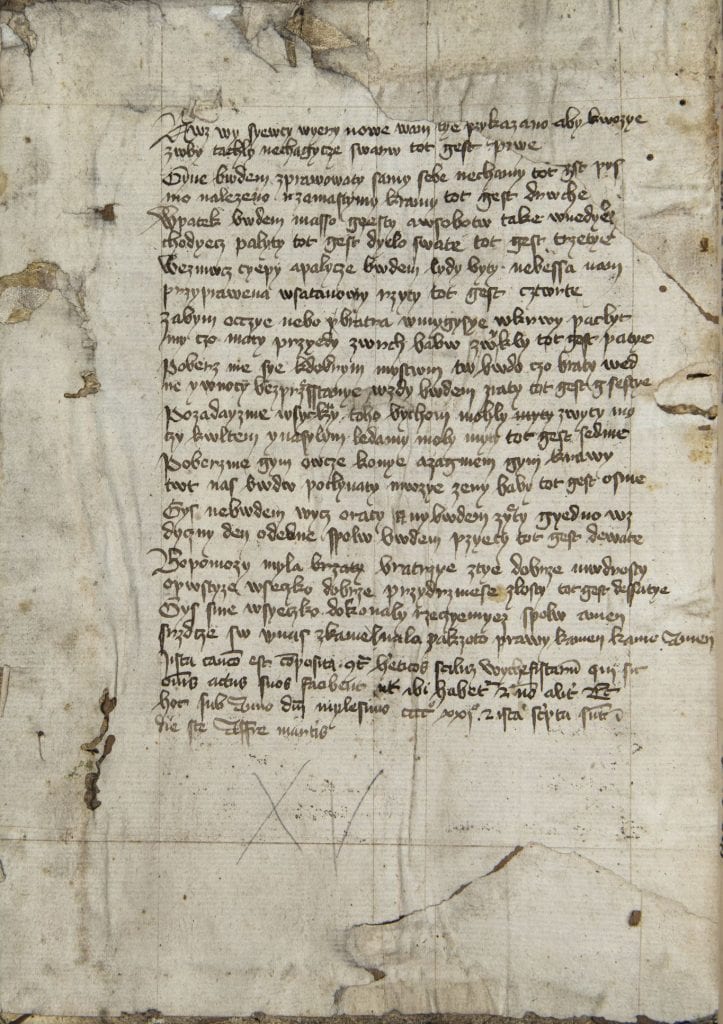| Author | unknown |
| Genre | Parody, Poem |
| Keywords | 15th century, Decalogue, Hussites vs. Catholics, paraphrase, parody |
| Title (in Czech) | Nuž, vy ševci viery nové |
| Title (in English translation) | Now, you shoemakers of the new faith |
| Editor | Kateřina Voleková |
| Translator | Lucie Doležalová |
| Edited source | Praha, Archiv Pražského hradu, fond Knihovna Metropolitní kapituly u sv. Víta, E XLIII, reverse side of the front cover |
| Introduction | Lucie Doležalová |
| TEI P5 XML Encoding | Michal Mocňák – Ondřej Svoboda – Boris Lehečka – Ondřej Tichý |
| Summary of content | A parody of a Hussite Decalogue song. |
Introduction to the Text
The song Nuž, vy ševci viery nové (Now, you shoemakers of the new faith) was composed in 1421. It is a Catholic parody of the most famous Medieval Czech Decalogue paraphrase Nuž, křesťané viery pravé (Now, you Christians of the true faith), a Hussite song from ca. 1415 written by Jan Čapek, a priest and one of the co-founders of Tábor (d. 1445?). This Hussite song survives in various manuscripts, among them the so-called Jistebnický kancionál (‘Jistebnice Hymn Book’, Praha, Knihovna Národního muzea, MS II C 7 [ca. 1420], pp. 51–52, fol. 32rv).
The first reference to the song Now, you shoemakers of the new faith was by Václav Flajšhans (see Flajšhans 1902, section Further reading), who published it in an amended version (see Flajšhans 1904, section Existing editions). The text has been edited several times, on the last occasion together with an English translation (see Existing editions).
Introduction to the Source
Written probably in the second quarter of the 15th century, it survives in a sole exemplar on the front inside cover of a Latin manuscript from the Library of the Metropolitan Chapter at St Vitus’ Cathedral, and is now housed in the Archives of Prague Castle under shelfmark E XLIII. As the exemplar contains many corrections, erasures and errors, it is likely to have been copied by an inexperienced scribe.
About this Edition
The translation by Lucie Doležalová is based on the more thorough of the previous editions, that by Kateřina Voleková which contains notes on the differences between itself and the previous edition, and on emendations and scribal corrections. Due to the frequent occurrence of inappropriate iotation in the manuscript, Voleková left cases of appropriate iotation in short syllables (e.g. kuože – in MS kwozye, cepy – in MS cyepy) without comment.
Existing Editions
Flajšhans, Václav, editor. “Desatero ševců z r. 1421” [The Decalogue of Shoemakers from the Year 1421]. Český lid, vol. 13, 1904, pp. 469–70 [amended version].
Patera, Adolf, editor. Některé málo známé památky veršované českého života náboženského a kulturního XV.–XVI. století [Some LittleKnown Versified Sources of Czech Religious and Cultural Life of the Fifteenth and Sixteenth Centuries]. Sborník historického kroužku, vol. 14. Družstvo Vlasť, 1913, pp. 63–64.
Nejedlý, Zdeněk. Dějiny husitského zpěvu [The History of Hussite Song], vol. 6. Nakladatelství Československé akademie věd, 1956, pp. 88–89.
Havránek, Bohuslav et al., editors. Výbor z české literatury doby husitské [An Anthology of Czech Literature of the Hussite Period], vol. 1. Nakladatelství Československé akademie věd, 1963, pp. 295–97 [with critical apparatus on p. 337].
Doležalová, Lucie. “Upon the posts and the doors of thy house”: The Ten Commandments in Late Medieval Bohemia. The Journal of Medieval Latin, vol. 18, 2018, pp. 221–25 [transcription of the Shoemakers’ Song by Kateřina Voleková, English translation by Lucie Doležalová].
Further Reading
Doležalová, Lucie. “Upon the posts and the doors of thy house”: The Ten Commandments in Late Medieval Bohemia, The Journal of Medieval Latin, vol. 18, 2018, pp. 211–40.
- This is a detailed study focusing on the transmission of texts dealing with the Decalogue in Late Medieval Bohemia, with special attention to the Shoemakers‘ Song.
Flajšhans, Václav. Paběrky z rukopisů kapitulních [Manuscript Snippets from the Chapter Library]. Věstník České akademie císaře Františka Josefa pro vědy, slovesnost a umění, vol. 11, 1902, p. 308, note.
- This publication discusses a mention of the song among other Old Czech manuscripts that are stored in the Library of the Metropolitan Chapter at St Vitus Cathedral.
